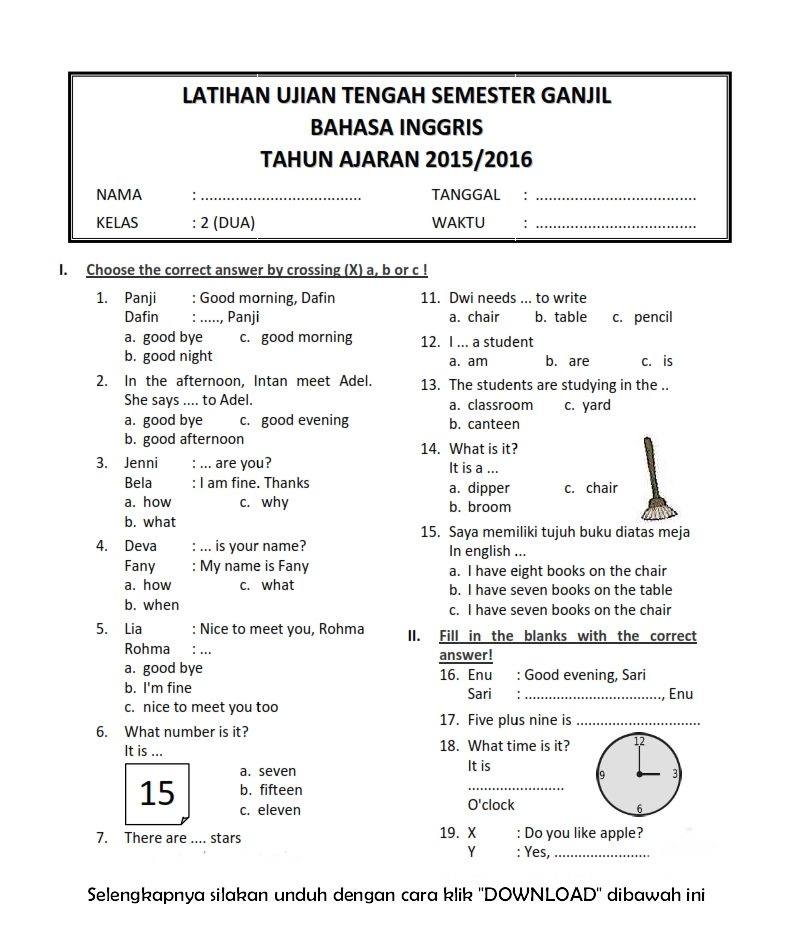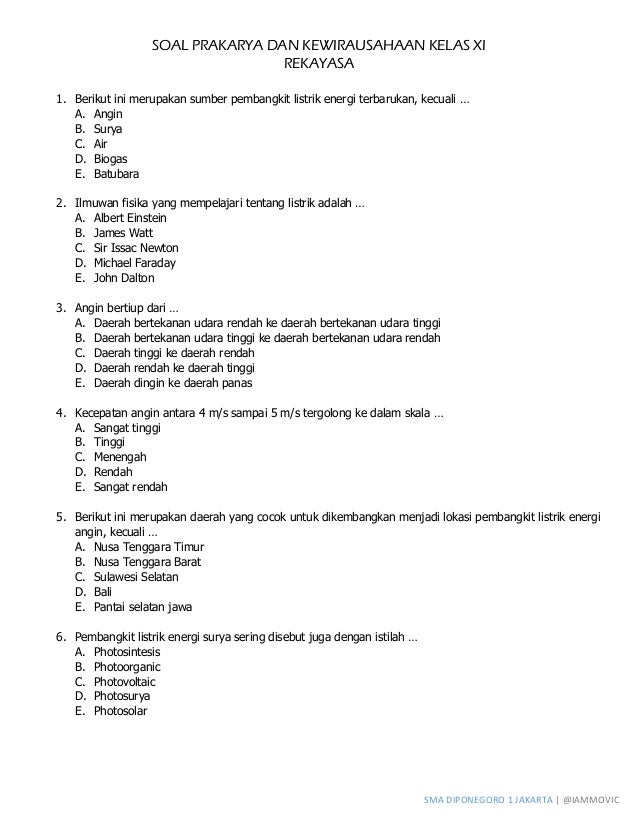Book Appointment Now

I. Introduction
A. Importance of English Language Learning in Elementary School
B. KTSP Curriculum Framework and its relevance to English Language Teaching
C. Scope of the Article: Focusing on Semester 2, Grade 3 English Material
II. Vocabulary Section:
A. Sample Questions and Answers Focusing on Vocabulary Related to:
- Animals (e.g., farm animals, wild animals, pets)
- Fruits and Vegetables
- Daily Activities
- Family Members
- Classroom Objects
III. Grammar Section:
A. Sample Questions and Answers Focusing on Grammar Points:
- Simple Present Tense (Affirmative, Negative, Interrogative)
- Plural Nouns (Regular and Irregular)
- Simple Sentences (Subject-Verb-Object)
- Wh-Questions (Who, What, Where, When, Why)
- Possessive Pronouns (My, Your, His, Her, Its, Our, Their)
IV. Reading Comprehension Section:
A. Sample Reading Passage (Suitable for Grade 3 Reading Level)
B. Comprehension Questions Based on the Passage (Multiple Choice, True/False, Short Answer)
V. Writing Section:
A. Sample Writing Prompt (e.g., describe your favorite animal, write about your daily routine)
B. Assessment Criteria for Evaluating Student Writing
VI. Listening Comprehension Section (Incorporating audio would be ideal for a real-world application, but text descriptions are provided here):
A. Sample Audio Script (Describing a simple scenario, e.g., a day at the zoo)
B. Listening Comprehension Questions Based on the Audio Script
VII. Speaking Section:
A. Sample Speaking Prompts (e.g., Introduce yourself, describe a picture)
B. Assessment Criteria for Evaluating Oral Proficiency
I. Introduction
Learning English is crucial for students, even at the elementary level. It equips them with essential communication skills for future academic success and global interaction. The Kurikulum Tingkat Satuan Pendidikan (KTSP) curriculum in Indonesia emphasizes a balanced approach to language learning, integrating various skills such as reading, writing, listening, and speaking. This article provides examples of English language questions suitable for Grade 3 students during the second semester, aligning with the KTSP framework. These examples cover vocabulary, grammar, reading comprehension, writing, listening comprehension, and speaking.
II. Vocabulary Section
This section focuses on building a solid vocabulary base for young learners. The questions are designed to assess their understanding of various topics.
A. Sample Questions and Answers:
-
Animals:
-
Question: Circle the farm animal: cat, cow, tiger, lion.
-
Answer: Cow
-
Question: Write the names of three wild animals.
-
Answer: Lion, elephant, tiger (or any other three appropriate wild animals)
-
Question: What is your favorite pet? Draw a picture of it.
-
Answer: (Student’s drawing and written answer, e.g., "My favorite pet is a dog. It’s fluffy and white.")
-
-
Fruits and Vegetables:
-
Question: Match the fruit to its picture: apple, banana, orange. (Pictures provided)
-
Answer: (Student matches the words to the correct pictures)
-
Question: Name two vegetables that are green.
-
Answer: Spinach, broccoli (or any other two green vegetables)
-
-
Daily Activities:
-
Question: What do you do in the morning? Write three sentences.
-
Answer: I wake up. I brush my teeth. I eat breakfast.
-
Question: Draw a picture showing what you do after school.
-
Answer: (Student’s drawing, possibly showing playing, doing homework, or other after-school activities)
-
-
Family Members:
-
Question: Who is your mother’s brother?
-
Answer: My uncle.
-
Question: Write the names of three family members.
-
Answer: Mother, father, sister (or any other three family members)
-
-
Classroom Objects:
-
Question: What do you use to write on the board?
-
Answer: Chalk or marker.
-
Question: Point to the book. (Teacher points to various classroom objects)
-
Answer: (Student points to the correct object)
-
III. Grammar Section
This section tests the students’ understanding of basic grammar concepts.
A. Sample Questions and Answers:
-
Simple Present Tense:
-
Question: Fill in the blanks: I ___ (go) to school every day.
-
Answer: go
-
Question: Write a negative sentence: The birds sing.
-
Answer: The birds do not sing.
-
Question: Write a question: He plays football.
-
Answer: Does he play football?
-
-
Plural Nouns:
-
Question: What is the plural of "cat"?
-
Answer: Cats
-
Question: What is the plural of "child"?
-
Answer: Children
-
-
Simple Sentences:
- Question: Write a sentence about a dog.
- Answer: The dog barks loudly. (or any other simple correct sentence)
-
Wh-Questions:
-
Question: Where is your pencil?
-
Answer: (Student points to or states the location of their pencil)
-
Question: When do you go to bed?
-
Answer: I go to bed at night. (or a specific time)
-
-
Possessive Pronouns:
-
Question: This is ___ book. (referring to the student’s book)
-
Answer: my
-
Question: That is ___ bag. (referring to a friend’s bag)
-
Answer: her/his
-
IV. Reading Comprehension Section
This section assesses the student’s ability to understand written text.
A. Sample Reading Passage:
(A simple story about a child going to the zoo, seeing animals, and having fun)
B. Comprehension Questions:
- Multiple Choice: What animal did the child see first? (a) lion (b) elephant (c) monkey
- True/False: The child had fun at the zoo.
- Short Answer: What did the child eat at the zoo?
V. Writing Section
This section evaluates the student’s writing skills.
A. Sample Writing Prompt:
Write about your favorite day of the week. What do you do?
B. Assessment Criteria:
- Sentence structure
- Vocabulary use
- Spelling
- Organization of ideas
VI. Listening Comprehension Section
(Note: An audio recording would be ideal here. The following is a text representation.)
A. Sample Audio Script:
A short audio describing a child visiting a park, playing on the swings, and seeing birds.
B. Listening Comprehension Questions:
- Where did the child go?
- What did the child play on?
- What did the child see in the trees?
VII. Speaking Section
This section evaluates the student’s oral communication skills.
A. Sample Speaking Prompts:
- Introduce yourself to the class.
- Describe the picture. (A picture is shown)
B. Assessment Criteria:
- Pronunciation
- Fluency
- Grammar accuracy
- Vocabulary use
These examples offer a comprehensive view of the types of questions that can be included in a Grade 3 English language assessment for the second semester, aligned with the KTSP curriculum. Remember to adapt the difficulty and content based on the specific learning objectives and the students’ individual progress. The use of visuals, real-life examples, and interactive activities can significantly enhance the learning experience and make assessment more engaging for young learners.



